We're an affiliate
We hope you love the products we recommend! Just so you know, we may collect a share of sales or other compensation from the links on this page at no additional cost to you. Thank you if you use our links, we really appreciate it!
“If water is essential for all living creatures, why won’t my cat drink water from her bowl?”, for new parents, this is one of the questions that can be challenging to resolve.
Without water, life may end as we know it. With 80% of water composing a cat’s body, it is clear that all biological processes need water, including circulation and digestion.
Drinking enough water helps your cat maintain healthy kidneys and supports other organs’ hydration. Kidney problems are more prevalent in cats than most people think.
According to a study by International Cat Care, 1 out of 3 cats can develop kidney problems in their lifetime due to poor hydrating habits.

You may be thinking, “If drinking water is important, why won’t my cat drink water from her bowl?” don’t worry because we got you covered.
There are many reasons for this behavior, and in this article, we will mention them and provide tips and tricks on how to get a cat to drink water.
How Much Water Cats Should Drink
According to a study conducted by Dr.Julia Fritz, DMV, healthy cats need daily between 100 to 130 mL of drinking water per 2 kg of body weight. That means if you have a 1-kg cat, she will need to consume about 50 to 65 mL of water daily.
Notice how we did not use the word “drink”? That’s because cats do not necessarily need to get their daily water needs just by drinking.
On average, a can of wet food is made up of about 70% to 80% water. Let’s say you feed your cat 100 grams of wet cat food a day.
That means your cat is already ingesting 80 mL of water. On the other hand, dry food only consists of 10% of water; therefore, more water intake should be given to your cat.
How To Know If Your Cat is Not Drinking Enough Water Daily?
If a cat doesn’t drink enough water daily, it could result in pressing complications. Dehydration happens when the normal body fluids, such as water and electrolytes, fall below the critical needs.
If your cat is not drinking enough water, it doesn’t mean they are already suffering from dehydration, but it’s often a fairly common reason or dehydration symptom.
It can be difficult to tell if your cat is dehydrated by just monitoring their water consumption. However, there are telltale signs that you can visually see to know if they are already experiencing dehydration:
1. Loose Skin
To check if your cat’s skin is loose, gently pull a bit of your cat’s skin located on their shoulders. It should quickly go back to normal placement once released; however, if your cat is dehydrated, their skin will reposition slowly.
2. Sticky Gums
If a cat’s gums feel dry and sticky, then they are most likely dehydrated. Healthy, hydrated cats generally have moist gums that exhibit their water intake.
3. Lethargy
If your cat suddenly becomes lazy and sleepy more than usual, they are likely to be dehydrated. Other visual signs are if your cat is less playful, doesn’t socialize with people around her, and is less likely to greet you when you arrive home.

4. Loss of Appetite
If a cat does not eat voluntarily, it is often a crucial sign that there something is wrong with their health, even if it’s not dehydration. Always monitor your cat’s food eating habits and if they don’t eat for more than 24 hours, it is best to go to your veterinarian.
5. Vomiting or diarrhea
A cat experiencing this vomiting or diarrhea will quickly become dehydrated due to the excessive excretion of vomit and bowel that contains mostly water.
6. Sunken Eyes
If your cat’s eyes seem to be sullen and sleepy, it is a sign that they are dehydrated.

7. Panting
Unlike dogs, our feline friends do not pant. But if they do, they might be overheated that can lead to dehydration.
8. Less Urination
Always examine your cat’s litter box for abrupt changes in urination and elimination. Keep in mind that if your cat is not peeing regularly, it can be a sign of urethral obstruction.
Can Cats Get Excessive Water Intake?
Excessive drinking of water is possible, and it can be a sign of feline hyperthyroidism or feline diabetes. If your cat suddenly starts consuming the above-average amount of water and also shows other symptoms, it is imperative to bring them to the veterinarian for an examination.
Why Won’t My Cat Drink From Her Bowl?
There are times when we see our cats drink water from a dripping faucet or your glass on the table, even though you just placed freshwater on their bowl.
It turns out that there are various reasons associated with a cat’s history from the wild that might refuse to drink from their bowl.
Here are ten reasons why they do not drink from their bowl.
1. Cats cannot hear the water from their bowl
Cats have a powerful sense of hearing, and the water in a bowl is invisible, making them think it is empty. The sound of dripping and flowing water entices them more to drink it.
This is why it is recommended to get a water fountain for your cat, they will enjoy drinking water much more.
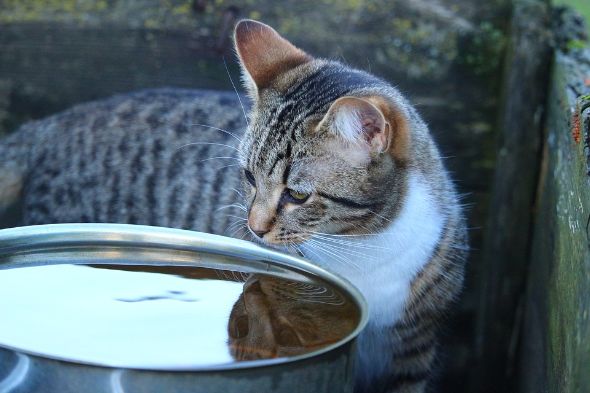
2. They are already getting hydrated from their food.
As we have tackled earlier, most canned wet food contains high moisture content. Additionally, cats from the wild get most of their daily water needs from the prey they eat and rarely need to drink water.
This instinct becomes hotwired with our domesticated cats.
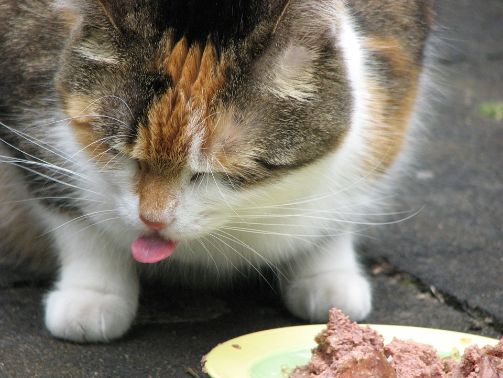
3. Avoid placing their bowl in one corner
Cats believe that facing away from their surroundings makes them easier prey, making them feel exposed and in danger.
4. Instinct tells them that stagnant water is not safe
Stagnant water outdoors is more prone to getting infected by bacteria and has the potential to make cats sick. Cats believe that running water is free from contamination, so cats will instinctively be drawn to it.
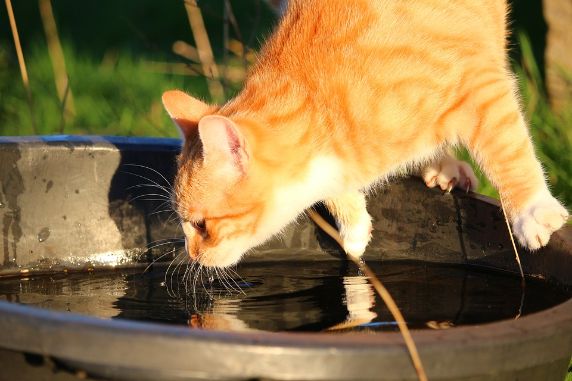
5. Running water feels colder
Admit it, drinking ice cold water hits differently than room temperature water. This is also true for cats. The temperature of water seems to affect the taste in a more pleasant way for your cat.
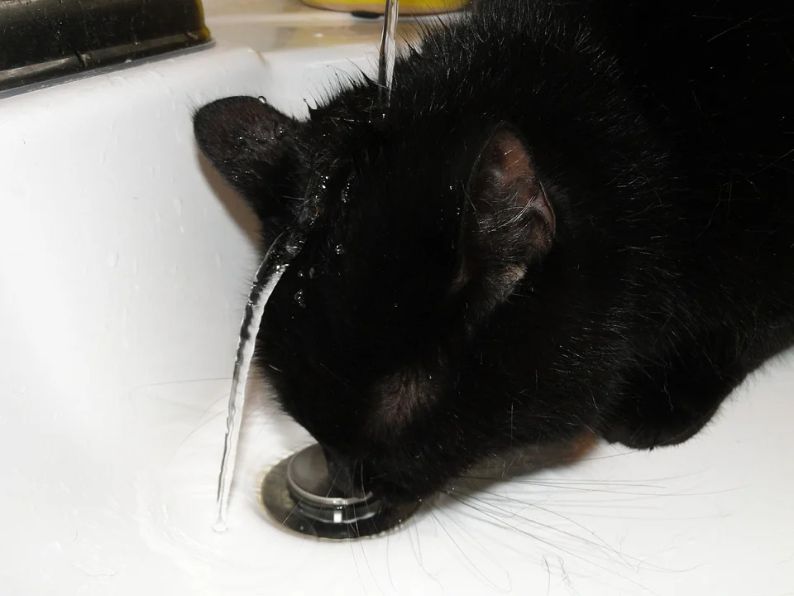
6. It’s too close to their food dish
Cats in the wild eat their prey far enough away from their water source to avoid contamination. For the same reason, cats do not like to drink from a water bowl close to their food bowl.

7. Their whisker touching the bowl makes them bothered
Cats have extra sensitive whiskers and they get whisker fatigue when they touch an object, messages are transmitted from the sensory organs on the base of their whiskers to their brain.
So when their whiskers suddenly touch the edge of the bowl, this can feel overwhelming to your cat.
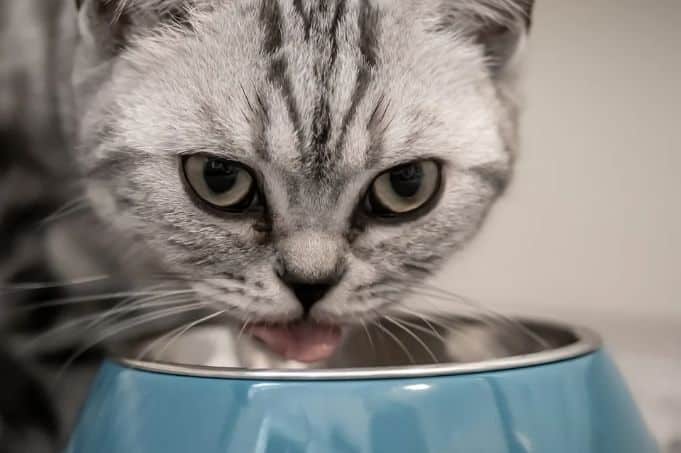
8. Dripping water is pleasurable to play with
Although cats are known for being hydrophobic, they still enjoy playing with drops of water with their paws. Playing with these water drops makes them feel much safer from it than splashing a big bowl of water.
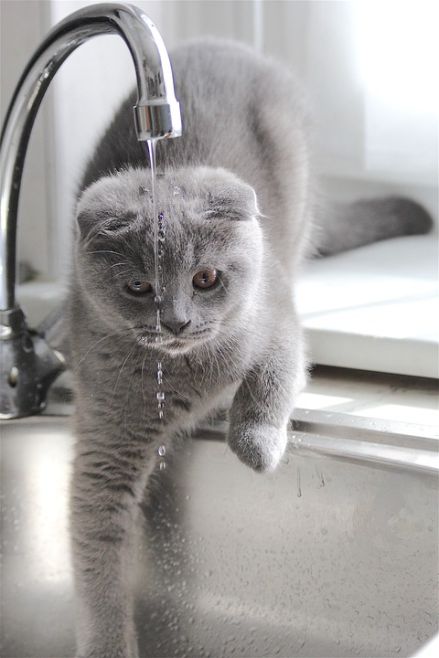
9. Running water tastes different
Cats can distinctly taste the difference between still water and running water. They feel like running water is more oxygenated, giving it a fresher, more quench-thirsting taste.
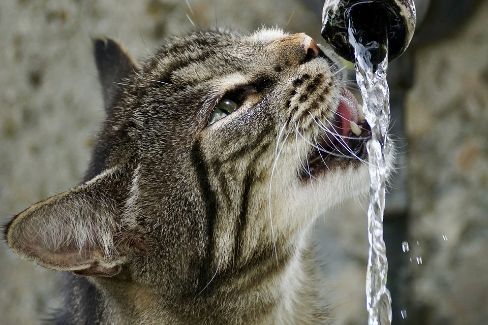
10. Tap water has fluoride
Fluoride is added by the government to tap water reservoirs to reduce the chance of having tooth decay. Although humans cannot taste the added fluoride, cats have a stronger sense of taste, which can be unpleasant for their drinking experience. So it is recommended to always give your cat drinking water.
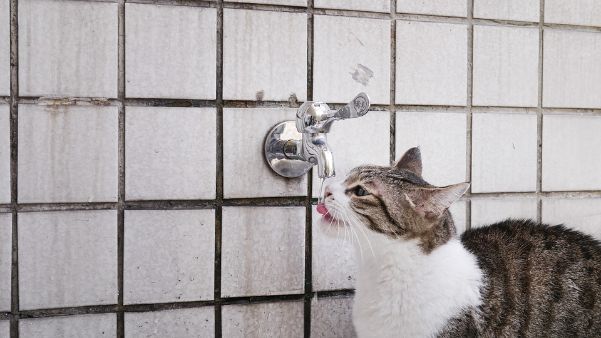
Tips to Get Your Feline Buddy To Drink More Water
There are various ways you can motivate your cat to drink more water for a healthier lifestyle. Here are some suggestions you can do to keep your cat hydrated.
1. Offer a diversity of bowls and glasses
Your cat may simply be particular and have specific preferences with her bowl. Use various styles of bowls to see which one your cat likes best.
There are three kinds of water bowls veterinarians recommend encouraging water drinking to your cats. These are:
- Wide Water Bowls
If you provide a large, wide bowl for your cat to drink in without rubbing her whiskers against the side, she will have a better time drinking from it.
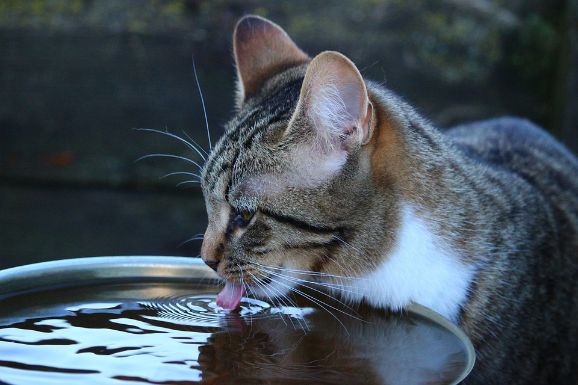
- Cold Water Bowls
Many cats prefer their water chilled, especially during hot days. If you get them a chilled water bowl, you’ll promote more water consumption as they will drink more frequently.
Fortunately, there are available chilled water bowls in the market that can keep the water chilled for longer hours. It is usually a stainless steel bowl with a removable base that you can freeze.
- Water Fountains
Since cats enjoy running water more, why not invest in a water fountain? Although it is pricier than the bowls above, it can ensure that your cat is getting more hydrated.

A water fountain is a bowl with a component that will make the water flowing all day long.
2. The more, the better
Avoid keeping your cat’s water bowls in just one place as it may discourage them from drinking. Instead, put bowls throughout your house, such as near the sink, on your kitchen counter, and in the bathroom.
Since cats love to wander, they will always take notice of these bowls, making them more enticed to drink from it.

3. Keep the bowl and water clean.
It is advisable to clean your cat’s bowl using soap and water every other day to remove any leftover smell from stagnant water. Ensure that the soap residues have been washed off to avoid poisoning. Once a week, sterilize the bowl by submerging it in hot water to eliminate any bacteria and lingering smell.
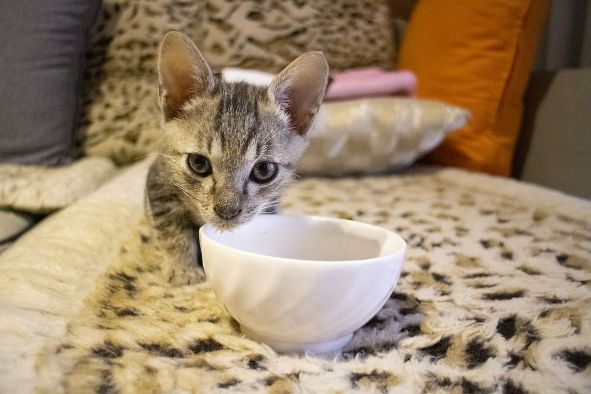
Some cats will refuse to drink from a dirty bowl, so it is better to change the water at least once or twice a day and check it to ensure that nothing has accidentally fallen into the bowl throughout the day.
4. Location of the bowl matters
Place the water bowls away from their food bowl or litter box. Although some cats don’t care if their water is close to the litter box or food bowl, it is best to assume that most cats do not like eating or doing business near their water bowl.
5. Make the water more “flavorful“
Adding a little flavor to your cat’s boring, tasteless water can make them drink more. Add a spoonful or two of tuna or chicken broth into your cat’s water for a more flavorful drinking experience.
You can also add crushed-up catnip in the water bowl to trick your cat into drinking from it. To get the best results, let your cat see you crushing some catnip in the bottom of the water bowl, so she knows it’s there.
6. Add some ice cubes
Some cats prefer cold water, plus, the ice cubes give them something to play with. First, add just one ice cube to each bowl so your cat will not get shocked by the change in temperature.
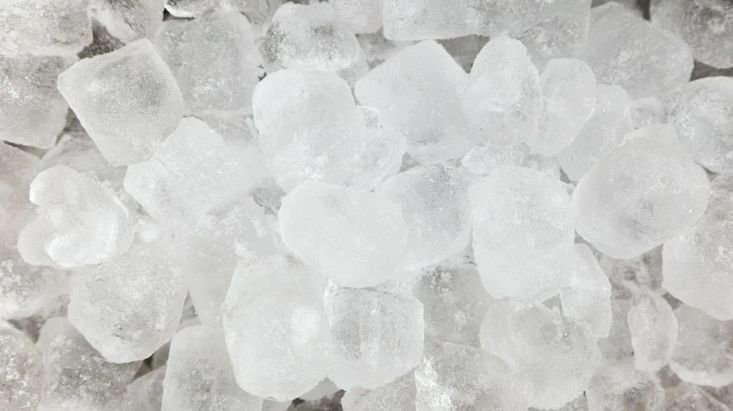
You can even combine flavored water with cold water by freezing broth in an ice cube tray and add it in your cat’s water bowl.
7. Switch to wet cat food
Although wet food is more expensive, it contains more moisture than dry cat food, making it perfect for finicky cats. Before any dietary changes, ask your veterinarian for advice.
Do not consider adding water to your cat’s dry food as this will only make it much less appealing, soggy, and can cause the food to spoil, increasing the chances of a stomach ache.
8. Feed your cat with smaller, more frequent meals
Most cats tend to drink after eating, much like humans, so try to feed them more than once or twice daily. Break your cat’s meals into many smaller ones to encourage your cat to drink more water often throughout the day.
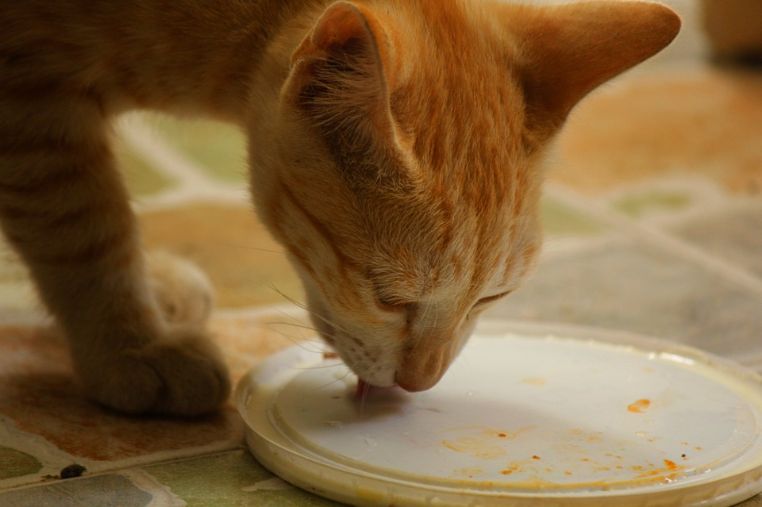
To Conclude
Whichever tip you choose, it is essential to encourage your feline friend to drink water. Getting your cat to drink enough water daily is just as important as feeding her a proper diet.
If your cat suddenly starts drinking notably more or less than usual, it is best to get her checked by your veterinarian.
Remember that the tips above are an adjustment to your cat’s daily routine, so patience is needed as it will take quite some time.
We hope we have helped you with your question on “Why won’t my cat drink water from her bowl?” Which methods did you use for your cat? How did it go? Comment down below and let our pet parent community know!
Laura is the founder of Furs'n'Paws. She is a also a pet writer and expert with more than 20 years of experience of working with dogs and cats. She developed a very strong love for animals at a young age. Her passion led her to establish a thriving pet sitting and dog walking business in Dubai. As an expert in pet training, behavior, and nutrition, Laura is committed to helping pet owners and pet lovers by offering high-quality information on a wide range of topics.


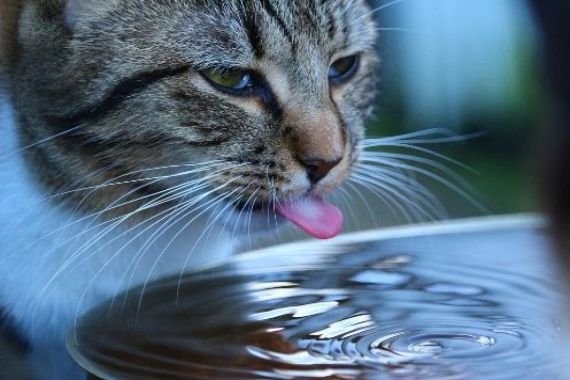
No responses yet